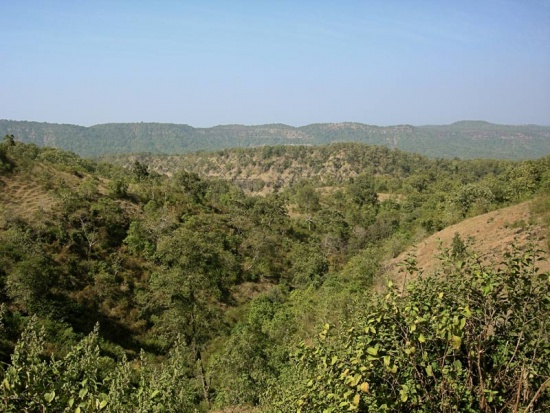Overview
Melghat Tiger Reserve lies in the Satpura Hill Range in Maharashtra, central India. The hills are covered with dry decidous forest, dominated by teak.
The reserve is an important site for tiger but they are hard to see here. Many forest birds can be found here but the prime target for many birders is the enigmatic Forest Owlet.
October to February is the best time to visit as many winter visitors (like Sulphur-bellied Warbler) are present. It can get quite cold in mid-winter so be sure to take a sweater with you. March to May is very hot and the rainy season lasts from June to September.
Birds
Notable Species
In total more than 270 species have been recorded in Melghat.
The prime attraction is without doubt the Forest Owlet. After its description in 1873 it has last been seen in 1884 and has long been thought to be extinct. It was rediscovered in 1997 in Central India. It is now known to be very localized and rare in the Satpura Range. Melghat is one of the few places where this species can be seen.
The rare Green Avadavat is another target for visiting birders although not easy to find. Other specialities include Sulphur-bellied Warbler and White-naped Woodpecker.
Check-list
Birds you can see here include:
Little Egret, Intermediate Egret, Indian Pond Heron, Striated Heron, Grey Junglefowl, Crested Serpent-Eagle, Black Eagle, Black-winged Kite, Shikra, White-eyed Buzzard, Common Kestrel, Indian Peafowl, Red-wattled Lapwing, Common Sandpiper, Oriental Turtle Dove, Spotted Dove, Plum-headed Parakeet, Rose-ringed Parakeet, Alexandrine Parakeet, Greater Coucal, Sirkeer Malkoha, Jungle Owlet, Forest Owlet, Crested Treeswift, Indian Roller, White-throated Kingfisher, Pied Kingfisher, Common Kingfisher, Asian Green Bee-eater, Indian Grey Hornbill, Coppersmith Barbet, Brown-headed Barbet, Brown-capped Pygmy Woodpecker, Yellow-crowned Woodpecker, Black-rumped Flameback, White-naped Woodpecker, Grey-throated Martin, Eurasian Crag-Martin, Red-rumped Swallow, Barn Swallow, Olive-backed Pipit, Tree Pipit, Grey Wagtail, Indian Cuckooshrike, Small Minivet, Red-whiskered Bulbul, Red-vented Bulbul, Common Iora, Long-tailed Shrike, Indian Blackbird, Oriental Magpie-Robin, Black Redstart, Indian Robin, Pied Bushchat, European Stonechat, Asian Brown Flycatcher, Red-breasted Flycatcher, Tickell's Blue Flycatcher, Grey-headed Canary-Flycatcher, Large Grey Babbler, Jungle Babbler, Yellow-eyed Babbler, Brown-cheeked Fulvetta, Grey-breasted Prinia, Ashy Prinia, Jungle Prinia, Siberian Chiffchaff, Tickell's Leaf-Warbler, Sulphur-bellied Warbler, Hume's Leaf-Warbler, Greenish Warbler, Lesser Whitethroat, Spot-breasted Fantail, White-browed Fantail, Black-naped Monarch, Indian Paradise-Flycatcher, Great Tit, Indian Black-lored Tit, Indian Nuthatch, Velvet-fronted Nuthatch, Indian White-eye, Common Tailorbird, Purple Sunbird, Pale-billed Flowerpecker, Scaly-breasted Munia, Green Avadavat, Common Rosefinch, House Sparrow, Yellow-throated Sparrow, Common Woodshrike, Black Drongo, White-bellied Drongo, Eurasian Golden Oriole, Common Myna, House Crow, Jungle Crow, Rufous Treepie
Other Wildlife
Tiger occurs but is hard to see. The best chances are on jeep safaris organised by the park itself. However even on this safaris less than 1 in 10 see a tiger.
Grey Langurs (or Hanuman Langurs) are often seen along the road. Wild boar, Gaur, Sambar, Nilgai, Barking Deer, Chital and Golden Jackal are sometimes seen from the road. Four-horned Antelope, Leopard, Wild Dog, Hyena and Sloth Bear are also recorded but are hardly ever seen by visiting tourists and birders.
Site Information
History and Use
The area is under protection since 1973. Large parts are declared National Park under the name Gugamal, the rest of the 1670km2 are the Melghat Sanctuary were some human interference is allowed.
Tourism is important for the region and many people from Nagpur, Indore or even Mumbai visit the reserve on weekends.
Areas of Interest
Interesting birds can be found around the Tourist Complex at Semadoh, including Green Avadavat.
The road from Semadoh to Chikhaldara (25kms) can be excellent for birding. You are not allowed to bird inside the forest, but the road is fine.
Around Chikhaldara birds of more open habitat can be found.
The Forest Owlet area is north of Semadoh and hard to find without guide.
Access and Facilities
The nearest airport is Nagpur from where you need some 5 to 6 hours to Chikhaldara. Trains from Mumbai to Nagpur stop in Badnera from where busses are available to Paratwada or to Chikhaldara (via Amravati).
You can stay in the minor hill resort of Chikhaldara outside the park or, more basic, in Paratwada or in the Information and Education centre in Semadoh.
To explore the park a car is most useful. In Chikhaldara the staff of the Harshawardhan Hotel can organise a guide to bring you to the Forest Owlet area (a 1,5hrs drive). Check with them before you arrive. Some Indian travel agents now also offer guided tours to the Forest Owlet, check on the Internet.
Birding in the reserve is only possible from the roads. Under the week there is only little traffic but be careful on weekends as the roads are narrow and have many bends.
To enter the reserve you have to pass checkposts and buy cheap day tickets. They normally open at 6.30am, but you may be able to pass before and convince the forest departement watchmen that you are just birding. Another checkpost in Chikhaldara costs 10Rs to pass each time. The money is used for the community.





